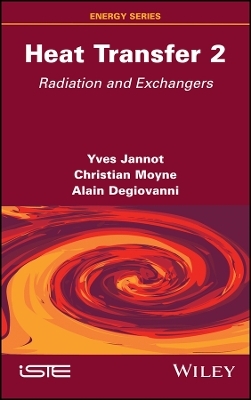
Heat Transfer, Volume 2
ISTE Ltd and John Wiley & Sons Inc (Verlag)
978-1-78630-928-0 (ISBN)
This book is designed for masters and engineering students who are interested in all aspects of heat transfer, but also for engineers who will find the bases needed to understand similar phenomena (conduction-convection-radiation), but which require a different form of reflection and approach.
Yves Jannot is a CNRS research engineer at the Energy, Theoretical and Applied Mechanics Laboratory of the University of Lorraine, France. Christian Moyne is CNRS research director at the Energy, Theoretical and Applied Mechanics Laboratory of the University of Lorraine, France. Alain Degiovanni is professor emeritus at the Energy, Theoretical and Applied Mechanics Laboratory of the University of Lorraine, France, and research director at the International University of Rabat, Morocco.
Preface ix
Nomenclature xi
Chapter 1 Heat Transfer by Radiation Between Surfaces 1
1.1 General: definitions 1
1.1.1 Type of radiation 1
1.1.2 Definitions 3
1.2 Laws of radiation 8
1.2.1 Lambert’s law 8
1.2.2 Physical laws 10
1.3 Reciprocal radiation of several surfaces 14
1.3.1 Radiosity and lost net flux 14
1.3.2 Geometric form factor 15
1.3.3 Flux calculation 16
1.3.4 Electrical analogy 18
1.4 Emission and absorption of gases 21
1.5 Solar radiation 22
1.5.1 Introduction 22
1.5.2 Geometric aspects 23
1.5.3 Atmospheric radiation 31
1.5.4 Solar radiation on the ground 33
1.6 Corrected exercises 41
1.6.1 Solar irradiance 41
1.6.2 Transmission of radiation 42
1.6.3 Dew formation 43
1.6.4 Influence of radiation on temperature measurements 46
1.6.5 Outdoor air temperature measurement 47
1.6.6 Apparent emissivity of a groove 49
1.6.7 Thermal equilibrium of a satellite 50
1.6.8 Heating of a filament bulb 51
1.6.9 Heat transfer by radiation in a refrigerated display case 53
1.6.10 Heating of a wall by radiation 55
1.6.11 Cooling a teapot 58
1.6.12 Study of thermal comfort 63
1.6.13 Calculation of the global loss coefficient of double glazing 66
Chapter 2 Radiation Heat Transfer in Semi-transparent Media 71
2.1 General 71
2.2 Definitions 73
2.2.1 Monochromatic coefficients 73
2.2.2 Luminance and radiative heat flux vector 75
2.3 Radiation balance 79
2.3.1 Radiation balance equation 79
2.3.2 Divergence of radiative heat flux vector 83
2.3.3 Example of radiation balance: the semi-transparent wall 85
2.3.4 Integral form of the radiation balance equation or formal solution 87
2.4 Special cases 88
2.4.1 1D non-scattering medium (with azimuthal symmetry) 88
2.4.2 Medium neither absorbent nor emissive 90
2.4.3 Optically thick medium 91
2.5 Conditions at the boundaries 94
2.5.1 Transparent boundaries 96
2.5.2 Opaque and black boundaries 96
2.5.3 Opaque boundaries, with diffuse emission and reflection 97
2.5.4 Opaque boundaries, diffuse emission, specular reflection 100
2.5.5 Semi-transparent interface 100
2.6 Example of an approximate solution: two-flux or Schuster–Schwarzschild approximation 102
2.6.1 Radiation balance 103
2.6.2 Special case of the gray medium 104
2.6.3 Special case of the gray and cold environment 105
2.7 Conduction–radiation coupling 108
2.7.1 Optically thick, gray and isotropically scattering medium 109
2.7.2 Purely scattering medium 110
2.7.3 Thin film model (low optical thickness) 112
2.7.4 Quadrupole for a non-scattering semi-transparent medium 112
2.8 Corrected exercises 113
2.8.1 Luminance of a semi-infinite medium 113
2.8.2 Measuring the temperature of an oven through a piece of glass 114
2.8.3 Radiative transfer between two opaque plates 116
2.8.4 Characterization of a cold semi-transparent medium 124
2.8.5 Characterization of a thin semi-transparent medium by flash method 128
2.8.6 Modeling the equivalent thermal conductivity of glass wool 130
2.8.7 Modeling a thermal conductivity measurement by hot plates 132
2.8.8 Calculation of the radiative properties of a plane wall 136
Chapter 3 Introduction to Heat Exchangers 143
3.1 Double-pipe heat exchangers 143
3.1.1 General: definitions 143
3.1.2 Expression of the exchanged heat flow rate 144
3.1.3 Efficiency of a heat exchanger 151
3.1.4 Number of transfer units 153
3.1.5 Calculation of a heat exchanger 154
3.2 Complex bundle heat exchangers 155
3.2.1 General 155
3.2.2 1–2 Heat exchanger 156
3.2.3 2–4 Heat exchanger 157
3.2.4 Cross flow heat exchanger 157
3.2.5 Refrigeration heat exchangers 159
3.3 Corrected exercises 162
3.3.1 Comparison of different types of heat exchangers 162
3.3.2 Calculation of a cross flow heat exchanger 165
3.3.3 Calculation of a plate heat exchanger 167
3.3.4 Calculation of an embedded evaporator 170
3.3.5 Sizing a condenser 172
Chapter 4 Flat Plate Solar Collectors 177
4.1 Principle 177
4.2 Global heat balance 178
4.2.1 Efficiencies of a solar collector 179
4.3 Thermal balances of the different constituents 181
4.3.1 Type 1 covered solar collector 181
4.3.2 Type 2 covered solar collector 186
4.3.3 Type 3 uncovered solar collector 187
4.3.4 Type 4 uncovered solar collector 189
4.3.5 Resolution method 190
4.4 Heat flow rate gained by the fluid as a function of the temperatures 191
4.4.1 Type 1 and 3 collectors 191
4.4.2 Type 2 and 4 collectors 193
4.5 Other characteristic quantities 198
4.5.1 Threshold radiation 198
4.5.2 Limit temperature 198
4.5.3 Pressure loss 199
4.6 Calculation method for a solar collector 200
4.6.1 Simulation of a solar collector 200
4.6.2 Simulation of a solar collector coupled to a storage 201
4.6.3 Dimensioning 202
4.6.4 Approximate calculation 202
4.7 Corrected exercises 203
4.7.1 Calculation of the loss coefficient of different types of collectors 203
4.7.2 Air heating in a solar collector 207
4.7.3 Solar water heater with covered tube collector 211
4.7.4 Collector-storage type solar water heater 215
4.7.5 Separate elements solar water heater 221
4.7.6 Collector with a cover semi-transparent to IR 223
Appendices 231
References 265
Index 269
Summary of Volume 1 273
| Erscheinungsdatum | 08.08.2023 |
|---|---|
| Verlagsort | London |
| Sprache | englisch |
| Gewicht | 694 g |
| Themenwelt | Technik ► Elektrotechnik / Energietechnik |
| Technik ► Maschinenbau | |
| ISBN-10 | 1-78630-928-9 / 1786309289 |
| ISBN-13 | 978-1-78630-928-0 / 9781786309280 |
| Zustand | Neuware |
| Haben Sie eine Frage zum Produkt? |
aus dem Bereich


